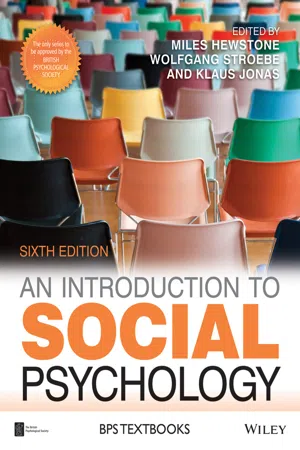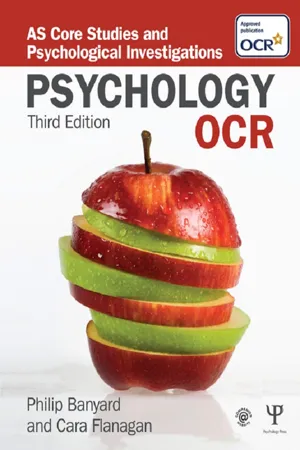Psychology
Piliavin Subway Study
The Piliavin Subway Study was a famous experiment conducted in 1969 to investigate bystander intervention in helping behavior. Researchers staged emergency situations in a New York City subway to observe how bystanders responded. The study found that factors such as the race of the victim and the presence of other bystanders influenced the likelihood of intervention.
Written by Perlego with AI-assistance
Related key terms
3 Key excerpts on "Piliavin Subway Study"
- eBook - ePub
- Miles Hewstone, Wolfgang Stroebe, Klaus Jonas, Miles Hewstone, Wolfgang Stroebe, Klaus Jonas(Authors)
- 2016(Publication Date)
- BPS Blackwell(Publisher)
do help. These approaches take a different kind of focus. Rather than emphasizing individual cognitive processes, they explore the role of physiology, emotion and group processes.The costs and rewards of helping
In contrast to Latané and Darley’s focus on explaining why people do not help, Piliavin and colleagues, contemporaries of Latané and Darley, set out to explain why people do help. Their ‘subway train studies’ (e.g., Piliavin, Rodin, & Piliavin, 1969), which involved the researchers staging emergency incidents on the subway trains of New York and then observing rates of intervention, provided some of the earliest bystander intervention studies that challenge the bystander effect. In one of the studies of Piliavin et al. a ‘victim’ (one member of a team of students who ran the field experiments) would stagger and collapse on a subway car while other members of the team recorded how many people helped. The trials were run with either black or white ‘victims’, all of whom were male. In some of the trials the ‘victim’ smelled of alcohol and carried a bottle wrapped tightly in a brown bag (‘drunk’ condition), while on other trials the ‘victim’ appeared sober and carried a black cane (‘cane’ condition).The researchers recorded the number of people who came to the victims’ assistance, and were surprised to find that helping was often at ceiling level, regardless of the number of other people present. Piliavin et al. (1969) reported that helping was offered by at least one bystander in 100 per cent of trials for all victims in the ‘cane’ condition, and for white victims in the ‘drunk’ condition; helping was shown in 73 per cent of trials for black victims in the ‘drunk’ condition. None of the bystanders left the subway car on any of the trials, but some people did leave the area in the immediate vicinity of the victim, particularly on the ‘drunk’ trials. Piliavin et al. concluded that, in their real-life ‘laboratory on wheels’, there was no strong relationship between number of bystanders and speed or likelihood of help. There was, however, a tendency for black individuals to help black victims, and for white individuals to help white victims. This tendency was particularly evident when the victim was drunk rather than if they carried a cane. The longer the emergency went on without any intervention, the more people were likely to move away. - eBook - ePub
OCR Psychology
AS Core Studies and Psychological Investigations
- Philip Banyard(Author)
- 2013(Publication Date)
- Psychology Press(Publisher)
et al. proposed that the first thing that happens in an emergency situation is:- Rewards.
- Costs.
- Arousal.
- Both a and b.
Exam-style questionsThere are three kinds of question that can be asked about the Piliavin et al. study, as represented here by sections A, B and C.See page x for further notes on the exam paper and styles of question.Section A questions
-
Previous psychological research found that people didn’t help in emergency situations due to diffusion of responsibility:
- What is meant by the term ‘diffusion of responsibility’? [2]
- Explain why this effect was not observed in the study by Piliavin et al. [2]
-
Piliavin et al. proposed a model of response to emergencies on the basis of the results from their study.
- Identify the two factors that influence a person’s decision to help or not. [2]
- Use these two factors to explain one of the results from the study. [2]
- In the study by Piliavin et al., describe what happened on each trial. [4]
-
- Describe one ethical issue that was a problem in the study by Pilialvin et al. [2]
- Describe how Piliavin et al. might have dealt with this ethical issue. [2]
-
Piliavin et al. designed a study where some of the researchers acted as ‘models’.
- Identify two of the model conditions. [2]
- Outline one conclusion that was drawn from these. [2]
- Piliavin et al. suggested that helping behaviour can be explained using an arousal/cost– reward model. Using this model suggest two ways of reducing arousal in the subway emergency. [4]
- Outline two practical problems that occurred in conducting the subway Samaritan study by Piliavin et al. [4]
- In the Piliavin et al. study outline one quantitative measure recorded by the observers and one qualitative measure. [4]
- Identify the four independent variables in study by Piliavin et al. [4]
- In the study by Piliavin et al. the victims were dressed identically as a control. Explain how one other control was used in this study. [4]
Section B questions
- eBook - ePub
International Express
New Yorkers on the 7 Train
- Stéphane Tonnelat, William Kornblum(Authors)
- 2017(Publication Date)
- Columbia University Press(Publisher)
The empirical research we have reviewed does contribute to a perception that the subway is a public place where its users typically avoid attention and retreat into their own mental worlds. This interior turn can create a hyperindividuated, self-absorbed social environment. The same research, however, also suggests that the reality is far more complex. The norms of civil inattention and preference for the role of spectator help explain why responsibility for action is diffused and why, for example, riders infrequently step out of the audience to fetch the bottle rolling across the car floor or take personal responsibility for other collective annoyances in the subway system. Nevertheless, communication and altruism are not absent on the trains.The possibility for altruism in the subway across the racial and ethnic backgrounds of riders was studied in a now-classic subway social experiment, “Good Samaritanism: An Underground Phenomenon?” by Irving Piliavin, Judith Rodin, and Jane Piliavin. They set up the following experimental “opportunity” for public altruism in the subway:A “victim” collapses on the subway during a non-stop 7½-minute journey. The trains are not particularly crowded when the staged event occurs, between the hours of 11:00 A.M . and 3:00 P.M . on a weekday. Sometimes he is helped, either by another passenger who steps forward after a short while, or after a number of minutes by a man (known as the model) who is also part of the experiment. The “victim” is either a black man or a white man acting as if he is drunk in one condition, and as if he is sober, but unsteady on his feet, in another (he carries a black cane). Two female observers record what happens.34The “victim” with a cane, regardless of his race, was helped more often and sooner than the drunk victim (sixty-two out of sixty-five trials for the cane victim, compared with nineteen out of thirty-eight trials for the drunk victim). Despite the differences in the time taken before help was offered, overall, subway riders were deemed “good Samaritans,” contrary to the common reputation of New York subway passengers.35None of these empirical studies or related journalistic accounts is entirely satisfactory. But they do describe a social order in which helping and staying back both occur, although with different probabilities. We learn from them that a given subway rider’s behavior is extremely situational, subject to relative and only vaguely understood variables. The studies show that the situations best indicating that people will not retreat behind their own sense of vulnerability and threatened territory are those in which they feel they are visible to others, “on the spot,” as well as how they actually interpret or categorize the situation.
Index pages curate the most relevant extracts from our library of academic textbooks. They’ve been created using an in-house natural language model (NLM), each adding context and meaning to key research topics.


